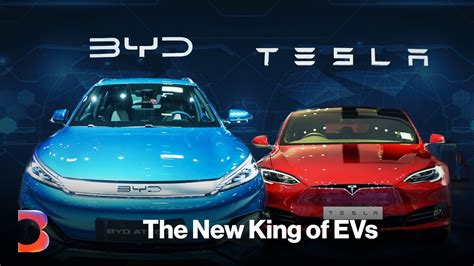
Electric vehicle (EV) drivers, increasingly frustrated with Tesla’s Autopilot system and other issues, are switching to Chinese automaker BYD, drawn by its competitive pricing and technological advancements. However, the transition isn’t without its challenges, primarily involving adapting to a different driving experience and navigating the intricacies of charging infrastructure compatibility.
Frustration with Tesla Drives EV Owners to BYD, but Challenges Remain
A growing number of electric vehicle owners, initially drawn to Tesla’s innovative technology, are now opting for BYD, a Chinese automaker rapidly gaining global market share. This shift is largely attributed to mounting frustration with Tesla’s Autopilot system, perceived quality issues, and increasingly competitive offerings from BYD. While BYD presents a compelling alternative, the transition comes with its own set of adjustments, particularly in adapting to a different user interface, driving dynamics, and the charging ecosystem.
The allure of BYD stems from several factors. Tesla owners have voiced concerns regarding the reliability and performance of Autopilot, Tesla’s advanced driver-assistance system (ADAS). Reports of phantom braking, inconsistent lane keeping, and other erratic behaviors have fueled dissatisfaction. “The promise of full self-driving has been a long time coming, and for many, the reality hasn’t lived up to the hype,” according to a recent survey of EV owners. This frustration is compounded by perceived quality control issues in Tesla vehicles, including panel gaps, paint imperfections, and electronic glitches, which are often highlighted on online forums and social media.
BYD, on the other hand, offers a compelling combination of competitive pricing and technological innovation. Its Blade battery technology, known for its enhanced safety and energy density, has garnered significant attention. Furthermore, BYD’s vehicles often come equipped with a range of features comparable to Tesla at a more accessible price point, making them attractive to budget-conscious consumers. “BYD is offering a lot of value for the money,” notes an automotive analyst. “They’re delivering a feature-rich EV experience at a price point that’s hard to ignore.”
However, the switch from Tesla to BYD is not seamless. Tesla’s Supercharger network, a key advantage for Tesla owners, provides a convenient and reliable charging experience. While BYD vehicles are compatible with various charging standards, the availability and accessibility of charging infrastructure outside of Tesla’s network can be a concern, particularly in certain regions.
Moreover, the driving experience differs significantly between the two brands. Tesla’s minimalist interior and focus on digital interfaces contrast with BYD’s more traditional approach. Some drivers may find BYD’s user interface less intuitive or its driving dynamics less engaging than Tesla’s. “It’s a different feel behind the wheel,” admits one Tesla convert. “It takes some getting used to, but the cost savings and the reliability are worth it for me.”
The shift towards BYD also reflects broader trends in the global EV market. Chinese automakers are rapidly expanding their presence, driven by government support, technological advancements, and a growing domestic market. BYD, in particular, has emerged as a major player, challenging Tesla’s dominance in key markets.
Diving Deeper: The Reasons Behind the Shift
Several underlying factors contribute to the growing trend of Tesla owners switching to BYD. These include:
-
Autopilot Disappointment: As mentioned earlier, the unfulfilled promise of full self-driving and the persistent issues with Autopilot are a major driver of dissatisfaction. Tesla’s Autopilot system, while innovative, has faced scrutiny for its limitations and occasional malfunctions. Drivers expecting a truly autonomous experience have been left disappointed, leading them to explore alternative options. The National Highway Traffic Safety Administration (NHTSA) has also launched investigations into Tesla’s Autopilot system, further fueling concerns about its safety and reliability.
-
Perceived Quality Issues: Tesla has faced criticism regarding the quality of its vehicles, with reports of manufacturing defects and inconsistent build quality. These issues, ranging from minor cosmetic flaws to more significant mechanical problems, have eroded consumer confidence in the brand. While Tesla has made efforts to address these concerns, the perception of quality issues persists among some owners. Online forums and social media platforms are replete with examples of Tesla owners detailing their experiences with quality-related problems.
-
Competitive Pricing and Value: BYD offers a compelling value proposition, providing a range of features and technologies comparable to Tesla at a more competitive price point. This is particularly attractive to budget-conscious consumers who are looking to transition to electric vehicles without breaking the bank. BYD’s ability to offer similar features at a lower cost is a key factor in its growing popularity.
-
Technological Advancements: BYD has made significant strides in battery technology, particularly with its Blade battery. This innovative battery design is known for its enhanced safety, energy density, and lifespan. The Blade battery is less prone to thermal runaway, a major safety concern in electric vehicles, and offers a longer range compared to traditional battery designs. BYD’s technological advancements have positioned it as a leader in the EV industry and a formidable competitor to Tesla.
-
Government Support and Market Expansion: The Chinese government has provided significant support to its domestic EV industry, including subsidies, tax incentives, and infrastructure development. This support has enabled Chinese automakers like BYD to rapidly expand their production capacity and market share. BYD has also been aggressively expanding its global presence, targeting key markets in Europe, Asia, and South America.
The Challenges of Switching: Charging Infrastructure and Driving Experience
While BYD offers a compelling alternative to Tesla, the transition is not without its challenges. These include:
-
Charging Infrastructure Compatibility: Tesla’s Supercharger network provides a seamless and convenient charging experience for Tesla owners. However, BYD vehicles are not compatible with the Supercharger network and rely on other charging standards, such as CCS (Combined Charging System). The availability and reliability of CCS chargers can vary significantly depending on the region, potentially leading to charging anxiety for BYD owners. While the charging infrastructure is constantly improving, it still lags behind the convenience and ubiquity of Tesla’s Supercharger network in many areas.
-
Driving Experience and User Interface: Tesla’s minimalist interior and focus on digital interfaces create a unique driving experience. BYD, on the other hand, adopts a more traditional approach, with a more conventional interior design and user interface. Some drivers may find BYD’s user interface less intuitive or its driving dynamics less engaging than Tesla’s. Adapting to a different driving experience can take time and may be a hurdle for some Tesla converts.
-
Brand Perception and Recognition: Tesla has established a strong brand image as a leader in electric vehicle technology. BYD, while rapidly gaining recognition, still lags behind Tesla in terms of brand awareness and perception, particularly in Western markets. Building brand trust and recognition is a key challenge for BYD as it expands its global presence.
-
After-Sales Service and Support: Tesla has invested heavily in its after-sales service and support network. BYD, as a relative newcomer to many markets, may not have the same level of service and support infrastructure in place. This can be a concern for potential buyers who value reliable after-sales service and support.
BYD’s Blade Battery: A Technological Edge
BYD’s Blade battery is a key differentiating factor that has contributed to its success. This innovative battery design offers several advantages over traditional lithium-ion batteries:
-
Enhanced Safety: The Blade battery is designed to be significantly safer than traditional lithium-ion batteries. It is less prone to thermal runaway, a dangerous phenomenon that can lead to fires and explosions. The Blade battery’s unique design and materials make it more resistant to overheating and damage.
-
Increased Energy Density: The Blade battery offers a higher energy density compared to traditional lithium-ion batteries. This means that it can store more energy in the same volume, resulting in longer driving ranges for electric vehicles.
-
Longer Lifespan: The Blade battery is designed to have a longer lifespan than traditional lithium-ion batteries. It can withstand more charging and discharging cycles without significant degradation in performance.
-
Cost-Effectiveness: BYD claims that the Blade battery is more cost-effective to produce than traditional lithium-ion batteries. This cost advantage allows BYD to offer its electric vehicles at a more competitive price point.
The Future of the EV Market: Competition and Innovation
The shift from Tesla to BYD reflects the growing competition in the global EV market. As more automakers enter the market and develop innovative technologies, consumers will have more choices and options. This increased competition will drive innovation and accelerate the adoption of electric vehicles.
Tesla, while still a dominant player, faces increasing pressure from competitors like BYD, Volkswagen, and General Motors. To maintain its competitive edge, Tesla will need to continue to innovate, improve its quality control, and expand its charging infrastructure.
BYD, on the other hand, needs to address the challenges of charging infrastructure compatibility, brand perception, and after-sales service. By overcoming these challenges, BYD can solidify its position as a major player in the global EV market.
The future of the EV market is likely to be characterized by intense competition and rapid innovation. Consumers will benefit from a wider range of choices, lower prices, and more advanced technologies. The transition to electric vehicles is accelerating, and the next few years will be crucial in shaping the future of the automotive industry.
Expanding Context: Government Policies and Global EV Adoption
Government policies play a crucial role in promoting the adoption of electric vehicles. Many countries and regions offer incentives such as tax credits, subsidies, and rebates to encourage consumers to purchase EVs. Governments are also investing in charging infrastructure to address range anxiety and make it easier for EV owners to charge their vehicles.
China, in particular, has implemented a comprehensive set of policies to support its domestic EV industry. These policies have helped Chinese automakers like BYD to rapidly expand their production capacity and market share. The Chinese government’s commitment to electric vehicles has made China the world’s largest EV market.
Other countries, such as Norway, the Netherlands, and the United Kingdom, have also implemented ambitious policies to promote EV adoption. These policies include banning the sale of new gasoline and diesel vehicles, providing financial incentives for EV purchases, and investing in charging infrastructure.
The global EV market is expected to continue to grow rapidly in the coming years, driven by government policies, technological advancements, and increasing consumer awareness. Electric vehicles are becoming more affordable, more efficient, and more convenient to own, making them an increasingly attractive alternative to gasoline-powered vehicles.
Tesla’s Response and Future Strategies
Faced with increasing competition, Tesla is actively working on several strategies to maintain its market leadership. These include:
-
Improving Autopilot and Full Self-Driving Capabilities: Tesla continues to invest heavily in its Autopilot and Full Self-Driving (FSD) technologies. The company is working to improve the reliability and performance of these systems and to address the concerns of drivers who have experienced issues. Tesla’s goal is to achieve truly autonomous driving capabilities, which would be a major competitive advantage.
-
Enhancing Quality Control: Tesla is also focusing on improving the quality control of its vehicles. The company has implemented new manufacturing processes and quality assurance measures to reduce defects and improve build quality. Tesla’s commitment to quality is crucial for maintaining consumer confidence and competing with established automakers.
-
Expanding Charging Infrastructure: Tesla continues to expand its Supercharger network globally. The company is adding new Supercharger stations in key markets and upgrading existing stations to support faster charging speeds. Tesla’s Supercharger network remains a significant competitive advantage, providing a convenient and reliable charging experience for Tesla owners.
-
Developing New Models and Technologies: Tesla is also developing new models and technologies to stay ahead of the competition. The company is working on new battery technologies, such as solid-state batteries, which could offer significant improvements in energy density and safety. Tesla is also exploring new vehicle designs and features to attract new customers and retain existing ones.
-
Lowering Prices: Tesla has also been adjusting its pricing strategy to remain competitive. The company has reduced the prices of some of its models to make them more accessible to a wider range of consumers. This price reduction is a response to increasing competition from other automakers, including BYD.
The Impact on the Automotive Industry
The rise of electric vehicles is having a profound impact on the automotive industry. Traditional automakers are scrambling to catch up with Tesla and BYD, investing billions of dollars in electric vehicle development and production. The transition to electric vehicles is also creating new opportunities for suppliers, battery manufacturers, and charging infrastructure providers.
The automotive industry is undergoing a major transformation, shifting from gasoline-powered vehicles to electric vehicles. This transformation is driven by environmental concerns, government policies, and technological advancements. The future of the automotive industry is electric, and companies that adapt to this change will be the winners.
FAQ Section:
1. Why are some Tesla owners switching to BYD?
Many Tesla owners are switching to BYD due to frustration with Tesla’s Autopilot system (citing issues like phantom braking), perceived quality control problems with Tesla vehicles (such as panel gaps and paint issues), and BYD’s competitive pricing and technological advancements, particularly its Blade battery technology. BYD offers comparable features at a lower price point, making it an attractive alternative.
2. What is the BYD Blade battery, and why is it significant?
The BYD Blade battery is an innovative battery design known for its enhanced safety (less prone to thermal runaway), increased energy density (leading to longer driving ranges), and longer lifespan. It’s also claimed to be more cost-effective to produce, contributing to BYD’s competitive pricing.
3. What are the main challenges of switching from Tesla to BYD?
The primary challenges include:
- Charging Infrastructure: Tesla’s Supercharger network is convenient and reliable, while BYD relies on other charging standards like CCS, which may have limited availability in some areas.
- Driving Experience: Tesla’s minimalist interior and digital interfaces differ from BYD’s more traditional approach, requiring adaptation.
- Brand Perception: Tesla has a stronger brand image, while BYD is still building brand recognition in some markets.
- After-Sales Service: Tesla has a well-established service network, while BYD’s may be less developed in certain regions.
4. How is Tesla responding to the increasing competition from BYD and other EV manufacturers?
Tesla is responding by:
- Improving its Autopilot and Full Self-Driving capabilities.
- Enhancing quality control in its manufacturing processes.
- Expanding its Supercharger network.
- Developing new models and technologies, such as solid-state batteries.
- Adjusting its pricing strategy to remain competitive.
5. What role do government policies play in the growing popularity of EVs like BYD?
Government policies, particularly in China, play a significant role. These policies include subsidies, tax incentives, and infrastructure development, which support domestic EV manufacturers like BYD and encourage consumer adoption. Other countries are also implementing similar policies to promote EV adoption.
Additional Points to Consider (For Expanding the Article Further):
-
Specific Tesla Model Comparisons: A detailed comparison of specific Tesla models (e.g., Model 3, Model Y) with comparable BYD models (e.g., Han, Atto 3) highlighting differences in range, performance, features, and price.
-
Consumer Reviews and Testimonials: Including more direct quotes and paraphrased accounts from Tesla owners who have switched to BYD, detailing their specific reasons and experiences.
-
Expert Opinions: Citing opinions from automotive journalists, industry analysts, and technology experts on the strengths and weaknesses of both Tesla and BYD vehicles.
-
Detailed Charging Infrastructure Landscape: Providing a more in-depth overview of the availability and reliability of different charging networks (CCS, CHAdeMO, etc.) in key markets, including comparisons of charging speeds and pricing.
-
Impact on Tesla’s Stock and Market Value: Analyzing the potential impact of increasing competition from BYD and other EV manufacturers on Tesla’s stock price and overall market valuation.
-
BYD’s Global Expansion Strategy: Examining BYD’s plans for expanding its presence in Europe, Asia, and other key markets, including its strategies for building brand awareness and establishing distribution networks.
-
Battery Technology Innovation: Discussing the ongoing research and development efforts in battery technology, including solid-state batteries and other advanced battery chemistries, and their potential impact on the EV market.
-
Sustainability and Environmental Impact: Exploring the environmental benefits of electric vehicles compared to gasoline-powered vehicles, including reduced greenhouse gas emissions and improved air quality.
-
Supply Chain Issues: Addressing the challenges related to the supply chain for EV components, particularly batteries and semiconductors, and their potential impact on EV production and availability.
-
Autonomous Driving Technology Landscape: Providing an overview of the current state of autonomous driving technology and the different approaches being taken by various automakers, including Tesla and BYD.
By incorporating these additional points and expanding on the existing content, you can create an even more comprehensive and informative article that provides readers with a deeper understanding of the shift from Tesla to BYD and the broader trends shaping the electric vehicle market.









